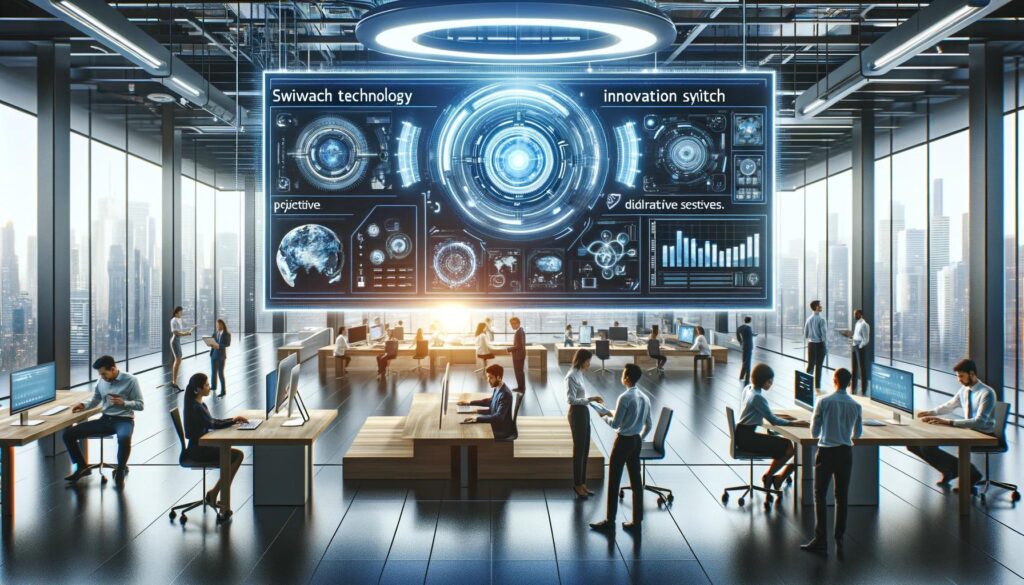
The Impact of Switches on the Evolution of Modern Work Environments
The landscape of modern workspaces is constantly evolving, driven by advancements in technology and a growing emphasis on efficiency, comfort, and sustainability. Among the innovations that have played a pivotal role in shaping these futuristic workspaces is the integration of switch technology. In this article, we will delve into how switches are revolutionizing and enhancing modern work environments.
Enhanced Ergonomics and Comfort
Switches have become indispensable tools for optimizing the ergonomic design of workspaces. Height-adjustable desks, ergonomic chairs, and monitor stands equipped with switches allow employees to personalize their workspace, creating a more comfortable and health-conscious environment. By simply pressing a switch, workers can raise or lower their desks to the desired height, reducing the risk of musculoskeletal issues and enhancing overall comfort during long working hours.
Smart Lighting Solutions
Switches have brought intelligence to lighting systems in modern offices. Smart lighting systems, controlled by switches and sensors, can automatically adjust the intensity and color temperature of lights to mimic natural daylight patterns. This not only reduces energy consumption but also enhances the well-being of employees by providing them with lighting that aligns with their circadian rhythms. Workers can also use switches to customize lighting to suit their preferences and tasks, boosting productivity and reducing eye strain.
Energy Efficiency and Sustainability
Switches play a crucial role in promoting sustainability within workspaces. Motion sensors connected to switches can detect occupancy and adjust heating, ventilation, and air conditioning (HVAC) systems accordingly, ensuring that energy is not wasted in unoccupied areas. Additionally, switches are used to control smart power outlets, enabling employees to easily turn off devices and appliances when not in use, further contributing to energy conservation and cost savings.
Streamlined Connectivity
In today’s digital age, seamless connectivity is essential for productivity. Switches facilitate the integration of various devices and technologies within the workplace. From Ethernet switches that enable high-speed internet connections to USB switches that simplify device sharing and data transfer, these technologies ensure that employees can work efficiently and collaboratively, regardless of their physical location within the office.
Enhanced Security and Access Control
Switch technology is also leveraged for enhancing security measures in modern workspaces. Access control systems utilize switches to manage entry to restricted areas. Biometric switches, card readers, and keyless entry switches provide secure and convenient access to authorized personnel while maintaining a record of entries and exits. This not only safeguards the workspace but also offers peace of mind to employees and employers alike.
Smart Meeting Spaces
Modern work environments often feature smart meeting spaces equipped with switches that simplify the setup and management of audiovisual equipment. Touchscreen switches and control panels enable users to control projectors, screens, sound systems, and lighting, ensuring that presentations and collaborative sessions run smoothly. These switches reduce downtime and enhance the overall efficiency of meetings and conferences.
Switches are at the forefront of transforming traditional workspaces into futuristic, efficient, and sustainable environments. Their impact on ergonomics, lighting, energy efficiency, connectivity, security, and meeting spaces has revolutionized the way we work. As technology continues to advance, we can expect even more innovative applications of switch technology that will further enhance the functionality and user experience in modern work environments.
Boosting Productivity and Unleashing Creativity through Switch Technology
In the ever-evolving landscape of modern workspaces and creative environments, the integration of switch technology has emerged as a game-changer. These unassuming devices have found their way into various aspects of our daily lives, revolutionizing the way we work and create. In this article, we will explore how switch technology is enhancing productivity and fostering creativity across diverse fields.
Streamlined Workflows
Switches have become indispensable tools for streamlining workflows in professional settings. Whether in office spaces or creative studios, switches are used to automate repetitive tasks. Programmable switches, for instance, can be configured to execute specific actions with a single press. This automation not only saves time but also reduces the risk of human error, allowing professionals to focus on more creative and complex aspects of their work.
Customized Workstations
The flexibility and versatility of switch technology have led to the creation of customized workstations that cater to the specific needs of individuals. Artists, designers, and professionals in various fields can personalize their workspace by using switches to control the height of desks, the angle of monitors, or the lighting conditions. This level of customization not only enhances comfort but also boosts productivity by providing an ideal work environment.
Creative Lighting Control
Lighting plays a pivotal role in setting the mood and ambiance of creative spaces. Switches have evolved to offer creative lighting control solutions that allow users to experiment with different lighting scenarios. From color-changing LED bulbs controlled by switches to dynamic lighting sequences that can be triggered at the press of a button, switch technology enables artists and designers to shape the visual atmosphere of their workspaces.
Interactive Art Installations
Switches have transcended their traditional roles to become integral components of interactive art installations. Artists are now incorporating switches into their works to engage viewers on a deeper level. These interactive installations often feature switches that allow participants to influence the artwork, changing its form, colors, or sound. Switches bridge the gap between the observer and the artwork, fostering a more profound connection and sparking creativity in the minds of viewers.
Collaborative Environments
Switch technology has also facilitated collaboration in various creative fields. In collaborative workspaces, such as design studios or music production studios, switches enable team members to seamlessly connect their devices, share resources, and switch between different work modes. This collaborative approach not only enhances productivity but also promotes the exchange of creative ideas and the development of innovative projects.
The Role of IoT and Smart Switches
The Internet of Things (IoT) has further elevated the impact of switches in enhancing productivity and creativity. Smart switches connected to IoT networks allow for remote control and automation of various tasks. Whether it’s adjusting the temperature, controlling multimedia devices, or managing lighting conditions, smart switches provide users with unprecedented control and convenience, allowing them to focus on their creative endeavors.
Switch technology has become a catalyst for enhancing productivity and nurturing creativity in a wide range of work environments. From streamlining workflows and customizing workstations to enabling interactive art and fostering collaboration, switches have proven to be versatile tools that empower individuals and teams to achieve their creative and professional goals. As technology continues to advance, we can anticipate even more innovative applications of switch technology that will further enhance productivity and creativity in the future.
Practical Implementations of Switches in Real Work Environments
Switches are not just electronic components but versatile tools that significantly impact the functionality and efficiency of various workspaces. In this article, we will explore real-life applications of switches in different professional settings, showcasing how these devices enhance productivity and streamline operations.
Office Ergonomics and Productivity
In modern office environments, switches play a crucial role in promoting ergonomics and productivity. Height-adjustable desks with electric switches allow employees to customize their workspace according to their comfort preferences. With a simple press of a switch, they can raise or lower the desk to the desired height, reducing the risk of musculoskeletal issues and increasing overall work efficiency. Additionally, ergonomic chairs equipped with switches enable users to fine-tune settings for optimal comfort during long hours of work.
Energy Management and Sustainability
Switches are at the forefront of energy management and sustainability efforts in workplaces. Motion sensors linked to switches detect occupancy within rooms, offices, or meeting spaces. These sensors then communicate with the building’s heating, ventilation, and air conditioning (HVAC) system, ensuring that energy is only expended when spaces are in use. This smart energy management not only reduces utility costs but also contributes to a greener and more sustainable workspace.
Smart Lighting Control
Switches have revolutionized lighting control systems in professional settings. Smart lighting solutions, controlled by switches and sensors, allow for automated adjustments of light intensity and color temperature. In conference rooms, for example, occupancy sensors can automatically brighten the lights when someone enters and dim them when the room is vacant, reducing energy consumption and ensuring optimal lighting conditions for presentations and meetings.
Access Control and Security
Switches are vital components of access control and security systems in workplaces. Access control panels equipped with switches regulate entry and exit points, ensuring that only authorized personnel have access to specific areas. Biometric switches, card readers, and keyless entry switches provide secure and convenient access management while maintaining a record of entries, enhancing the overall security of the workspace.
Connectivity and Networking
Switch technology is instrumental in maintaining seamless connectivity and networking within offices and corporate environments. Ethernet switches enable high-speed data transmission, ensuring fast and reliable internet connections for employees. In addition, USB switches facilitate device sharing and data transfer, streamlining collaborative efforts and enhancing productivity in shared workspaces.
Conference Room Automation
Switches are central to the automation of conference rooms and meeting spaces. Touchscreen switches and control panels allow users to manage audiovisual equipment, such as projectors, screens, sound systems, and lighting, with ease. These switches simplify the setup and operation of equipment, reducing downtime and ensuring efficient and productive meetings and presentations.
Switches are indispensable tools that enhance functionality and efficiency across a wide range of workspaces. From promoting office ergonomics and sustainable practices to enabling smart lighting control, access management, connectivity, and conference room automation, switches have a significant impact on the productivity and comfort of employees in various professional settings. As technology continues to advance, we can expect further innovations in switch technology that will continue to revolutionize the way we work.
Pioneering Office Design with Cutting-Edge Switch Technology
The landscape of office design is undergoing a profound transformation, driven by technological advancements that are reshaping the way we work. At the forefront of this revolution is the integration of advanced switch technology. In this article, we will explore how the future of office design is being shaped by the innovative applications of switches, enhancing both functionality and aesthetics.
Ergonomics and Workspace Customization
Office ergonomics have taken center stage in the design of modern workplaces. Switches are playing a pivotal role in creating customized workstations that prioritize employee comfort and well-being. Height-adjustable desks, controlled by electric switches, allow employees to effortlessly modify their desk height to their preferred level. This adaptability reduces the risk of ergonomic-related health issues and fosters a more productive and comfortable work environment.
Smart Lighting Solutions
The incorporation of smart lighting systems controlled by switches is revolutionizing office illumination. These systems adjust lighting levels and color temperature dynamically throughout the day to mimic natural daylight patterns. Occupancy sensors linked to switches ensure that lights are only active in occupied areas, conserving energy and reducing utility costs. Smart switches also empower employees to tailor lighting to their preferences, promoting a conducive work atmosphere and minimizing eye strain.
Energy Efficiency and Sustainability
Switch technology is a driving force behind the push for energy efficiency and sustainability in office design. Motion sensors connected to switches detect room occupancy and communicate with heating, ventilation, and air conditioning (HVAC) systems. This intelligent control minimizes energy consumption in unoccupied spaces, reducing the carbon footprint of office buildings. Additionally, switches are utilized for controlling smart power outlets, enabling employees to power down devices and appliances when not in use.
Collaborative Workspaces and Connectivity
Switch technology fosters collaboration in modern offices by facilitating seamless connectivity. Ethernet switches ensure high-speed internet connectivity, while USB switches simplify device sharing and data transfer among colleagues. These technologies enable collaborative efforts in shared workspaces, enhancing communication and productivity.
Access Control and Security
Security is a paramount concern in office design, and switches are instrumental in access control systems. Access control panels equipped with switches regulate entry and exit points, ensuring that only authorized personnel have access to sensitive areas. Biometric switches, card readers, and keyless entry switches provide secure and convenient access management while maintaining a comprehensive record of entries and exits.
Interactive Meeting Spaces
The integration of switches into meeting spaces is reshaping how teams collaborate and share ideas. Touchscreen switches and control panels simplify the management of audiovisual equipment, including projectors, screens, sound systems, and lighting. These switches empower employees to set up and operate equipment effortlessly, reducing downtime and enhancing the efficiency of meetings and presentations.
In conclusion, advanced switch technology is at the forefront of revolutionizing office design. From promoting ergonomic workstations and smart lighting solutions to enhancing energy efficiency, connectivity, security, and interactive meeting spaces, switches are redefining the modern office environment. As technology continues to advance, we can anticipate even more innovative applications of switch technology that will further elevate the functionality and aesthetics of office spaces, creating workplaces that are not only efficient but also conducive to employee well-being and productivity.





